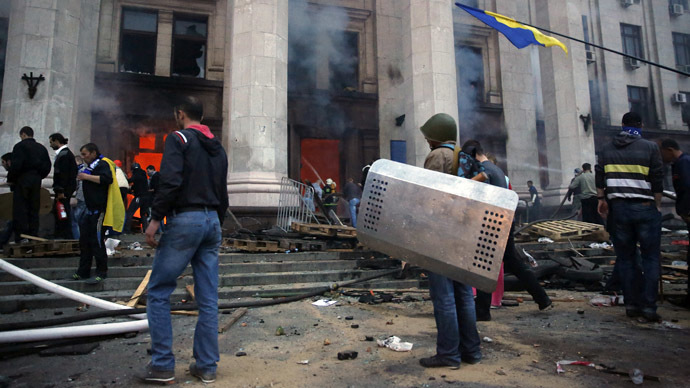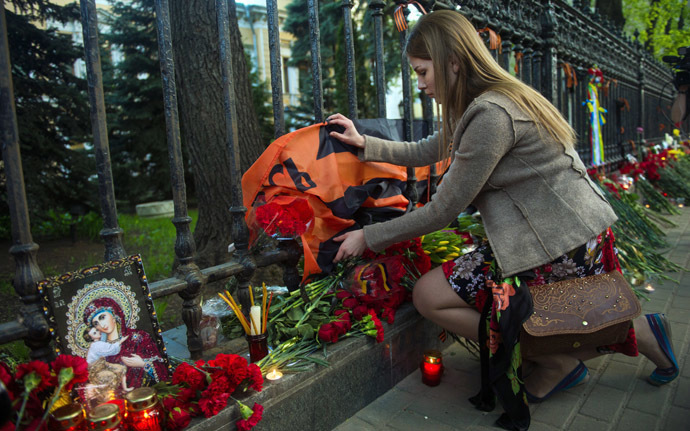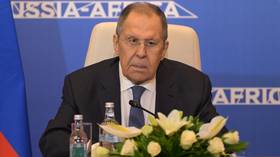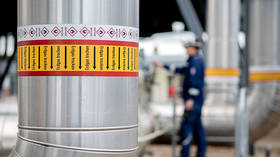How the corporate media whitewashes Ukraine

Cities in eastern and southern Ukraine have become battlefields as the junta in Kiev has unleashed military and paramilitary thugs on the people of those regions.
At the same time the media, with its critical role in shaping public opinion, has also become one of the principal theaters in this ongoing conflict, with Western propaganda being one of the most potent weapons.
Seventy-three years ago this October, the infamous “Odessa Massacre” of 1941, which killed more than 30,000 Jews in the Ukrainian port city and surrounding areas, was carried out by Romanian fascist troops in collaboration with their Nazi patrons and allies. The pogrom, merely one of many against Jews and other minorities in Ukraine, is a stark historical reminder to the people of Odessa (and all those throughout the former Soviet Union who fought against fascism during the war) of the depravity, inhumanity, and barbarism of Nazis and their collaborators.
And now, 73 years later, Odessa is the scene of yet another horrific war crime carried out by fascists against innocent civilians. The fire and massacre at the Trade Unions building which killed dozens of anti-fascist activists and employees in the building, will serve as a painful testimony to the ongoing struggle against the junta in Kiev and its neo-Nazi paramilitary foot soldiers. This obvious war crime, along with a number of others committed by the Right Sector and other ultra-nationalist (read fascist) militias, should undoubtedly be the issue making headlines around the world.
And yet, it seems that somehow the slaughter of innocents, and the issue of criminal accountability for those who ordered and carried out the massacre, has been completely and systematically distorted and/or omitted from the Western narrative. Instead, the corporate media has deliberately attempted to obscure the true nature of the events of that day, and those leading up to and subsequent to it, in order to dilute the impact of the self-evident, and quite damning, criminality of the fascist militias and their leaders and patrons. By using subtle, coded language that deliberately minimizes the barbarism of the events and shifts blame from Kiev to Moscow, the mainstream Western media once again acts as the dutiful servant of the US-EU ruling establishment.

What they are saying (and not saying)
In examining the way in which the events in Odessa, and those that have taken place in other regions since May 1, have been portrayed, a few common features emerge. First and foremost is the language used to describe the anti-fascist demonstrators who made up the majority of the victims in Odessa. In a woefully dishonest and biased article published by Reuters entitled “Ukraine moving police special forces to control Odessa,” the authors utilize critical terminology such as “pro-Russian separatists” and “militants,” in fact using them interchangeably as a means of “branding” the activists as something other than peaceful Ukrainians demonstrating for their rights.
Naturally, the phrase “pro-Russian separatists” is entirely misleading on a number of levels. First, the anti-fascist, anti-junta activists (as they should rightly be labeled) are not separatists in the true sense of the word. They do not seek secession outright, but have been demonstrating for weeks in favor of a federalized Ukraine where the rights of Russian-speakers and other minorities would be respected and constitutionally guaranteed. They were demanding that their long-standing historical, familial, and economic ties with Russia not be severed by force of an illegal government in Kiev and its paramilitary shock troops. Far from being “separatists” these activists, scores of whom have already been killed, injured, and/or taken prisoner, have been standing up for a just and peaceful Ukraine instead of the ochlocracy brought about by the junta.
It is equally important to note the use of the word “militants” to describe the anti-junta activists. The implication of using such a designation has to do with assigning guilt to the serious crimes that have been committed. Essentially, by referring to the victims of the crimes as “militants,” this justifies the actions taken by Right Sector and other fascists by portraying them as necessary and just in the fight against the “pro-Russian militants.” Moreover, designating the activists as militants is an attempt to insulate the illegal government in Kiev from the obvious war crimes charges that they would face were the propaganda mouthpieces in the media actually reporting the story factually. And so, by using such terminology, the media is, in effect, providing political cover to a criminal regime backed by the West. This is certainly par for the course.
The same Reuters article focuses broadly on the move by the junta’s Interior Minister Arsen Avakov to create a new “special forces unit” to replace the Odessa police which, according to Avakov, committed an “outrageous” failure by releasing dozens of survivors who had been taken into custody and held as prisoners without receiving proper medical care. The article discusses Avakov’s statement about the creation of “Kiev-1,” a special unit made up of “’civil activists’ who wanted to help the Black Sea city “in these difficult days.’”

Naturally, there is no direct mention of exactly who will be part of this new special force, other than a passing reference to the fact that “The units Avakov referred to emerged partly from the uprising against Yanukovich early this year.” This is unmistakably a veiled reference to Right Sector and other fascist paramilitary forces which, in contrast to regular police and Ukrainian military, can be counted on by Kiev to carry out war crimes and other atrocities against anyone they perceive as “Moskals” (a derogatory term for Russians and Russian-speakers).
Another critical feature of the article which serves the propaganda agenda of the West is the description of the events that led the Odessa police to release dozens of the survivors-turned-prisoners. The authors of the article describe the peaceful demonstration that surrounded the police headquarters demanding the release of their friends and family utterly dishonestly. The article states, “Kiev's anger on Monday focused on the Odessa police decision to release 67 largely pro-Russian militants after supporters besieged and stormed a police station [emphasis added] on Sunday.”
By describing the peaceful protest as “besieging and storming,” the reader is given the impression that the “separatists” (also referred to as “terrorists” and “rebels” by the criminal regime in Kiev and its patrons in the West) are the true initiators of violence and conflict. Naturally, though the opposite is true, the seed is planted in the public consciousness. Thus the activists are branded, like a common consumer product or a public relations campaign.
And so, the Reuters article successfully obscures the nature of the new force, its actual role, the crimes committed on the ground, and the nature of the opposition. By doing so Reuters, like the New York Times and its corporate media brethren, successfully spreads misinformation and disinformation in the service of the US-EU-NATO imperial system.
In fact, the aforementioned New York Times, refusing to be outdone, published its own highly biased and propagandistic article on the events in Odessa and throughout the East and South. Entitled “Ukraine’s Reins Weaken as Chaos Spreads,” the article presents Kiev, and specifically the junta’s Prime Minister Yatsenyuk (handpicked by the West), as victims of Russian treachery, portraying him as a victim of Russian aggression and provocation. After quoting Yatsenyuk’s inflammatory, distortion-filled statement in which he blamed the victims in Odessa, referring to the events as “resulting from a well-prepared and organized action against people, against Ukraine, and against Odessa,” the Times reporter then went on parrot Kiev and Washington’s talking points on the subject.

The articles states that “Mr. Yatsenyuk said the violence showed that Russia wanted to rekindle unrest in Odessa, as it had in eastern Ukrainian cities.” Immediately following this statement, which is the product of hearsay rather than substantiated evidence, the article proceeds to discuss Russian “imperial ambitions” as evidenced by Crimea and Putin’s alleged desire to reestablish Russian dominion over “Novorossiya” (New Russia). This is a standard tactic of misinformation and propaganda: create an association in the mind of the reader such that an abstract relationship (Protesters=Russian militants=Putin=Russian imperialism) becomes the rubric by which all developments are measured and understood.
Finally, the Times article also attempts to suppress the reality of both Odessa and the eastern region of Donetsk, which has been the center of much anti-fascist, anti-junta organizing, including the declaration of the People’s Republic of Donetsk. The reporter writes, “The violence on Friday and the freeing of prisoners on Sunday highlighted a distinction between Odessa and the east: In both places, the police have sided with rebels. But here, local pro-Kiev activists routinely field street fighters ready to confront the Novorossiya group, with lethal consequences on Friday.” Essentially, the purpose of this sentence is four-fold.
First, it is to substantiate the claim made by Yatsenyuk that police forces are “criminal” because they refuse to take part in the suppression and violence directed towards their brothers and sisters, cousins and neighbors, completely glossing over the fact that this unmistakably indicates that the majority of people want nothing to do with the so-called “anti-terror” operation being conducted by Kiev’s forces.
Second, the excerpt shows how deceptively the corporate media is handling the issue of public opinion. The author completely glosses over, with no explanation, the fact that in each city in the South and East, the police and many military units have sided with the protesters, rather than carry out their criminal orders from Kiev. An objective story would highlight this fact in demonstrating that the junta in Kiev does not rule with the consent of the people and that it, in fact, is a minority ruling through violence, intimidation, and Western backing. In burying this important aspect of the story, the author and his editors have engaged in utterly transparent propagandizing of the issue in the service of the West.

Third, the excerpt illustrates the precariousness of presenting Washington’s PR-friendly version of facts. By using the phrase “local pro-Kiev activists,” the article completely whitewashes the true nature of the forces that committed the atrocity. Far from being “activists,” the so called “pro-Kiev” forces were actually Nazi paramilitary groups including Right Sector which not only likely set the initial blaze, but was also documented on video as beating the survivors with chains and clubs, denying them emergency medical care, and more. But, by describing these criminals as activists, the Times does yeoman’s work for Washington and Kiev, establishing a biased framework within which readers would perceive the conflict.
Finally, the way in which the article designates the groups as “Kiev activists” versus the “Novorossiya group” is a transparent propaganda ploy designed to, once again, create a false dichotomy in the minds of ill-informed readers. The fascist mobs are merely “activists,” while the anti-Kiev protesters are the “Novorossiya group,” meaning they are not Ukrainians with their own agency, but are agents of Russian imperialism. The author purposely denies the agency of these protesters in order to both legitimize the criminal actions of the fascists, and de-legitimize the peaceful protests of the anti-fascist opposition. Dishonesty might not be a strong enough word to describe such underhanded journalistic tactics.
The grisly events in Odessa, as well as the deadly assaults on Slovyansk, Kramatorsk and other eastern cities, undoubtedly mark a turning point in the conflict in Ukraine. More than merely an important moment, these criminal actions represent a “point of no return,” the moment at which any hopes for a peaceful and bloodless resolution to the crisis were dashed. Despite the droning propaganda emanating from Western corporate media, the world cannot and should not excuse these horrific war crimes. More to the point, they should serve as a reminder that the struggle for Ukraine has a price, one which could have been denominated in dollars, euros and rubles. But now, thanks to Kiev, Brussels, and Washington, the price will be paid in blood.
The statements, views and opinions expressed in this column are solely those of the author and do not necessarily represent those of RT.
The statements, views and opinions expressed in this column are solely those of the author and do not necessarily represent those of RT.













